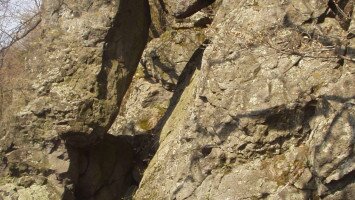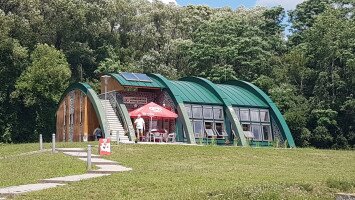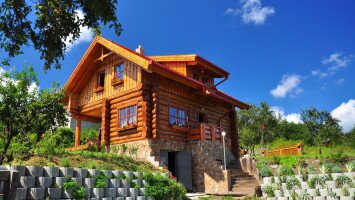
Ősmaradvány mítoszok Ipolytarnócról
Egy vulkáni katasztrófa elpusztította és egyben megőrizte az "Ősvilági Pompejit" Ipolytarnócon. A különös kövületek és vulkáni jellenségek egymás melletti megjelenése keltette fel a helyi palócok figyelmét, akik magyarázatot kerestek létezésükre. A népi fantázia termékeny, mesés történetek sarjadnak az egykor letűnt világ emlékeiről, amelyek a 17 millió éves vulkáni fedőrétegek repedései közül újra előkerülnek.
Azt hitték, hogy régen egy gonosz varázslóélt a környéken, aki távozása előtt, haragjában kővé dermesztette az életet. Bizonyos értelemben igazuk volt, hiszen egy vulkánkitörés volt, amely varázsütésre megőrizte az ősi élet maradványait.
Íme az ipolytarnoci vulkán/varázsló és a megkövesedett élet mítoszának részletei az Ásatag/Petrified gyűjteményéből:
A kövesedett fa matuzsálem
A tarnóci nagy kövesedett fát az 1700-as évek vége felé kezdte kibontani a vulkáni törmelékes kőzetből az erózió. A Borókás-patak kimosta alóla a jóval puhább vulkáni port, egy 42 m-es darabja szép lassan, mint egy kőhíd kezdte átívelni az alatta kialakuló árkot, majd vízmosást.
Az arra járó helybéliek előszeretettel üldögéltek rajta, felismervén fa eredetét “Gyurtyánkő Lócza” névre keresztelték el. Egy kegyetlen mágus által elvarázsolt fának (gyertyánnak) gondolták, melyben a mágia most is, igaz megdermedve, de ott dereng.
Ezért ha valaki, tiszta szívvel megérinti, ráteszi tenyerét, és lenyugodott elmével kitárja vágyát a kőfának, a mágia hatalma átszivároghat és teljesítheti a kívánságot. De jaj annak, akit másnak ártó szándék vezérel az óhajtásban, a varázslat ellene fordul és úgy megdermeszti szívét, hogy szeretetet az már többet nem adhat, de be sem fogadhat.
Cápafogak
Az alsó-miocén sekélytenger homokos partszegélyi üledékeiből előkerült cápafogak is megragadták a helybéliek fantáziáját. Alakjuk miatt megkövült madárnyelveknek nevezték el őket. Miért is? Íme egy lehetséges magyarázat.
Amikor a nagy varázsló kővé dermesztette a hatalmas fát az énekes madarak ijedten felrebbentek róla, szerte repültek, riadtan adva a világ tudtára a szörnyű eseményt. A varázsló, hogy elhallgattassa őket, kővé változtatta nyelvüket, mely csőrükből kiesve szertehintette a környéket. A tájon sokáig csend honolt, halotti csend.
Lám, ha a varázsló a vulkánt személyesíti meg, akkor megtaláljuk a kőfa konzerválóját, a vulkánkitörés elpusztította az ősélőhelyet, száműzve az élet dallamát a katasztrófa utáni holdbéli tájról.
Lábnyomok
A nagy kövesedett fa melletti erózió lassan lehordta a finom vulkáni portufát az ősi váztalaj lábnyomos homokkövéről, fokozatosan kibontakoztak az ősi lények lábnyomai a múlt homályából. A helybéliek ” Kőmedencze” néven emlegették a lecsupaszított, viszonylag lapos felszínt, melyen az alkonyi, súroló napfény adta ki igazán a kővé dermedt lábnyomok plaszticitását.
Sokszor a babona erősítheti a közösséget. A helybéliek azt hitték, ha ebben a napszakban a jegyes párok táncot ropnak a lábnyomos homokkövön, akkor egybekelésük utáni, közös házastársi lépteik is olyan időtállók lesznek, mint a kővé dermedt lábnyomok. A hálás utódok pedig időtlen időkig emlékezni fognak a lábnyomos homokkövön fogadalmi táncot lejtő őseikre. Lám a múlt így is összetart.
A vulkánok is hozzájárulhatnak az emberi kapcsolatok erősítéséhez, igaz, lehet, hogy több millió év eltelte is kell hozzá, meg a helyi hitvilág magyarázat keresése. Hiszen esetünkben az ignimbritból kimosódó kovasav konzerválta a fát és a lábnyomokat. No meg a vulkanizmus nekünk is varázslatos, nem csak az ókori görögök számára, ugye egyetért velünk az olvasó?!?














